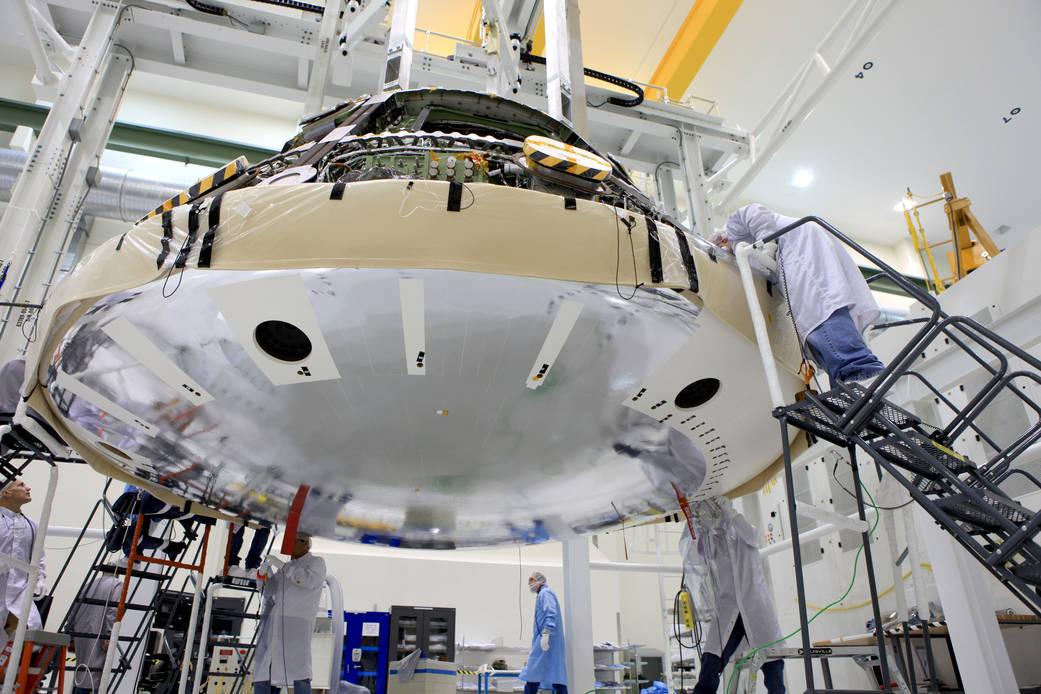
HOUSTON—At the close of NASA’s upcoming Artemis I test flight, an uncrewed Orion capsule will re-enter the Earth’s atmosphere faster and hotter than any previous human spacecraft, validating the heat shield’s ability to protect astronauts returning from the Moon and eventually Mars.
With a planned Aug. 29 liftoff from NASA’s Kennedy Space Center (KSC), the Artemis I Orion capsule is to make a high velocity re-entry and splashdown in the Pacific Ocean off the coast of San Diego on Oct. 10. A U.S. Navy recovery vessel with divers and NASA personnel will be waiting to retrieve the spacecraft for a rigorous post-flight evaluation.
“We will take all that data and look at the temperatures we measured as a function of time related to the trajectory that we ended up actually flying,” said Ronny Backus, NASA’s Orion spacecraft chief engineer, during a series of Aug. 5 news briefings and interview opportunities at Johnson Space Center here. “Then we can deduce what kinds of margins we have in the system and compare that with our preflight predictions. Then maybe based on the lessons learned, we have actually got a little more operational capability than I’ve given myself credit for. Then we would play that forward in future mission planning.”
That could mean more flexibility in scheduling the launch windows and the lunar returns for Artemis missions with astronauts that are to follow, starting with the Artemis II lunar fly-around currently planned for late 2024. “That is what we are looking for,” Baccus said.
According to the Artemis I flight plan, Orion is to re-enter the Earth’s atmosphere at an altitude of about 400,000 ft. and estimated velocity of 25,000 mph. Then it will slow to about 300 mph due to atmospheric friction, generating external temperatures of about 5,000F, equivalent to half that on the surface of the Sun. Spacecraft re-entering from low Earth orbit heat up to about 3,000F.
To help manage the extreme thermal environment as well as anticipated internal gravity forces that would be 12 times normal for an onboard astronaut crew, the Artemis I Orion will carry out a first-ever “skip” maneuver for a crewed spacecraft. After initial atmospheric re-entry, the capsule will use its aerodynamic contour to rise briefly out of the Earth’s atmosphere. The “skip” is also to permit adjustments to the guidance and navigation to accurately target the desired splashdown point using technologies and computing capabilities not available during the Apollo era. Once demonstrated, the “skip” capability will offer mission planners flexibility in plotting the return leg of Artemis missions not completely dependent on the timing or location of the lunar departure.
Once the descent resumes, atmospheric friction should slow the descending spacecraft to about 300 mph again, before eight parachutes begin to deploy in the first of three sequences, beginning with two drogue chutes at an altitude of 25,000 ft., slowing Orion to about 100 mph within a minute.
Three pilot parachutes are to deploy, followed by a trio of main parachutes that are to slow the spacecraft to less than 20 mph before it splashes down close to a U.S. Navy recovery vessel.
The time between the entry of the Orion capsule into the atmosphere and splashdown is expected to be between 15 and 23 min., according to NASA’s Melissa Jones, Artemis I mission recovery operations director at KSC.
Orion’s heat shield has a heritage that dates back to NASA’s smaller Apollo Moon capsule, though with modifications.
The current design evolved in part from the uncrewed Earth orbital Exploration Flight Test-1 (EFT-1) of Orion performed on Dec. 5, 2014. Launched aboard a Delta IV rocket from Cape Canaveral Space Force Station, Florida, the capsule rose to a peak altitude of 3,600 mi., achieving a re-entry velocity of 20,000 mph, exposing the heat shield to a maximum temperature of about 4,000F before it successfully splashed down under parachute in the Pacific Ocean.
Based on post EFT-1 analysis, advances in technology, modeling and ground tests, the Artemis I Orion capsule, like those of Apollo, is protected with an ablative material called AVCOAT. AVCOAT allows the Thermal Protection System (TPS) to absorb heat from re-entry as flakes are charred away, lowering thermal energy.
But the procedures for providing the Orion’s TPS system have changed.
Instead of having the production team fill 300,000 honeycomb cells individually with the ablative material, as was done for Apollo, the Orion AVCOAT heat shielding is manufactured in blocks. Just less than 200 in total, the blocks are machined and bonded in place over Orion’s 16-ft.-wide thermal protection system that is layered atop the capsule’s rugged carbon-fiber skin.
“The main objective of this mission is to test the heat shield. The reason is because we can never 100% test the heat shield performance on the ground,” said Frank Lin, NASA’s Orion vehicle manager. “We want to understand how the heat shield really works.”
After post-flight recovery, the heat shield will be removed from the capsule and disassembled to assess what the actual ablation rate was in response to factors that include the mass of the spacecraft and the angle of re-entry.
Also critical to the capsule’s safe return is the parachute system. The parachute deployment strategy has been developed and exercised over 25 previous high-altitude drop tests from aircraft, Jones said.
Artemis I will also mark the debut launch of the Space Launch System and its Orion payload, followed by the planned 18-min. SLS second stage Trans-Lunar Injection burn 1 hr. 38 min. into the mission, which is to propel Orion out of Earth orbit and on its way around the Moon.
As the 42-day mission winds a close, Orion’s European Space Agency-provided Service Module will furnish the propulsion for the return flyby maneuver that will send the spacecraft soaring about 500 mi. above the Moon’s surface for a lunar gravity assist to start the capsule on its way back to Earth.





